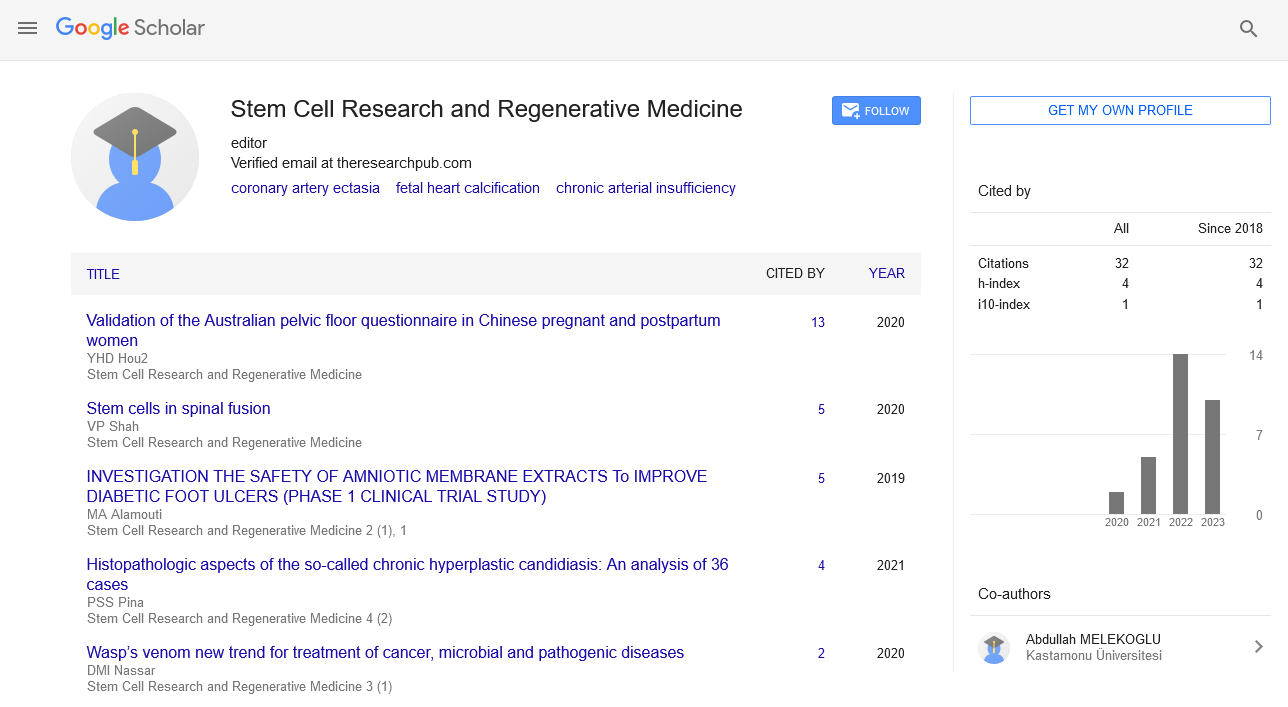Perspective - Stem Cell Research and Regenerative Medicine (2024) Volume 7, Issue 4
Organoids: A New Frontier in Biomedical Research and Regenerative Medicine
- Corresponding Author:
- Jianmin Li
Department of Biomedical Engineering,
University of Antarctica,
Milan,
Italy
E-mail: Lijimina@outlook.com
Received: 26-Jul-2024, Manuscript No. SRRM-24-145822; Editor assigned: 29-Jul-2024, Pre QC No. SRRM-24-145822 (PQ); Reviewed: 12-Aug-2024, QC No. SRRM-24- 145822; Revised: 21-Aug-2024, Manuscript No. SRRM-24-145822 (R); Published: 28-Aug-2024, DOI: 10.37532/SRRM.2024.7(4).223-224
Introduction
Organoids have emerged as a revolutionary tool in biomedical research, offering unprecedented insights into human development, disease modeling, and potential therapeutic applications. These Three-Dimensional (3D) structures, derived from stem cells, mimic the architecture and function of real organs on a miniature scale. Over the past decade, organoids have transformed the study of human biology by providing models that more accurately reflect the complexity of human tissues than traditional Two-Dimensional (2D) cell cultures. As the field continues to evolve, organoids are poised to play a critical role in personalized medicine, drug discovery, and regenerative therapies.
Description
The science behind organoids
Organoids are generated by culturing stem cells under specific conditions that promote selforganization and differentiation into cell types characteristic of particular organs. These stem cells can be either Embryonic Stem Cells (ESCs) or induced Pluripotent Stem Cells (iPSCs), both of which possess the ability to differentiate into any cell type in the body. By carefully controlling the growth environment, researchers can coax these cells to form 3D structures that recapitulate key aspects of organ development.
The process of organoid formation relies on the inherent ability of stem cells to organize into complex structures. This self-organization is driven by intrinsic genetic programs and the interactions between cells, which are influenced by signaling pathways and the extracellular matrix. As a result, organoids can develop multiple cell types and structures, such as epithelial layers, vasculature, and even rudimentary organ functions, depending on the organ they represent.
Applications of organoids
Disease modeling: One of the most significant applications of organoids is in disease modeling. Traditional 2D cell cultures often fail to capture the complexity of human tissues, limiting their utility in studying diseases that involve intricate cellular interactions and 3D architecture, such as cancer and neurodegenerative disorders. Organoids, by contrast, provide a more physiologically relevant model that can mimic the microenvironment of real organs.
For example, brain organoids have been used to study neurological disorders like microcephaly, Zika virus infection, and autism spectrum disorders. These models allow researchers to observe the development of brain structures and identify the specific stages at which abnormalities occur. Similarly, cancer organoids, derived from patient tumor samples, have enabled the study of tumor heterogeneity, drug resistance mechanisms, and personalized treatment strategies.
Drug screening and personalized medicine
Organoids also hold tremendous potential for drug screening and personalized medicine. Because organoids can be derived from a patient’s own cells, they provide a unique platform for testing how individual patients might respond to specific drugs. This approach, known as organoid based personalized medicine, allows for the identification of the most effective treatment with the fewest side effects, tailored to the genetic and molecular profile of each patient.
In drug development, organoids offer a more predictive model for evaluating drug efficacy and toxicity. Traditional drug screening methods often rely on animal models, which do not always accurately reflect human biology. Organoids bridge this gap by providing human-specific insights into drug responses, potentially reducing the time and cost associated with bringing new therapies to market.
Regenerative medicine
The potential of organoids extends beyond research and drug discovery into the realm of regenerative medicine. Organoids could one day be used to repair or replace damaged tissues in patients, offering new treatments for conditions such as liver failure, kidney disease, and gastrointestinal disorders. For instance, liver organoids have been developed that can perform basic liver functions, such as detoxification and protein synthesis, making them potential candidates for transplantation.
While the use of organoids in clinical settings is still in its early stages, advances in tissue engineering and biomaterials are bringing this vision closer to reality. Researchers are exploring ways to integrate organoids with existing tissues, vascularize them to support long-term survival, and scale up production to meet clinical needs. If successful, organoids could provide a source of transplantable tissue that is both patient-specific and immune-compatible, overcoming many of the challenges associated with traditional organ transplantation.
Challenges and ethical considerations
Despite their promise, the development and use of organoids present several challenges. One of the primary technical challenges is ensuring that organoids accurately replicate the complexity and function of full-sized organs. While organoids can mimic many aspects of organ development, they are still relatively simple compared to the organs they represent. This simplicity can limit their utility in certain applications, such as modeling diseases that involve complex interactions between multiple organ systems.
Another challenge is the reproducibility of organoid production. Variability in the differentiation process can lead to inconsistencies between organoids, making it difficult to compare results across different experiments or laboratories. Standardizing protocols and improving the precision of organoid generation are critical steps toward overcoming this hurdle.
Ethical considerations also come into play, particularly as organoid technology advances. For example, brain organoids that exhibit rudimentary neural activity raise questions about the definition of consciousness and the ethical implications of creating complex brain models. Additionally, the use of organoids in personalized medicine could lead to issues of accessibility and equity, as these advanced therapies may be expensive and not widely available.
Future directions
The future of organoid research is bright, with numerous possibilities for advancing our understanding of human biology and developing new therapies. As technology improves, we can expect organoids to become more complex and functionally accurate, enabling even more sophisticated disease models and therapeutic applications.
One exciting area of research is the integration of organoids with microfluidic devices, known as “organ-on-a-chip” technology. This approach allows researchers to simulate the interaction between different organs, providing a more comprehensive model of human physiology. Additionally, advances in gene editing, such as CRISPR/Cas9, offer the potential to create organoids with specific genetic modifications, enabling the study of genetic diseases and the development of gene therapies.
Conclusion
Organoids represent a new frontier in biomedical research, offering powerful tools for disease modeling, drug discovery, and regenerative medicine. While challenges remain, the potential benefits of organoids are vast, promising to transform our approach to understanding and treating human diseases. As the field continues to evolve, organoids are likely to play an increasingly central role in the future of medicine, bringing us closer to the realization of personalized and regenerative therapies tailored to the individual needs of patients.


